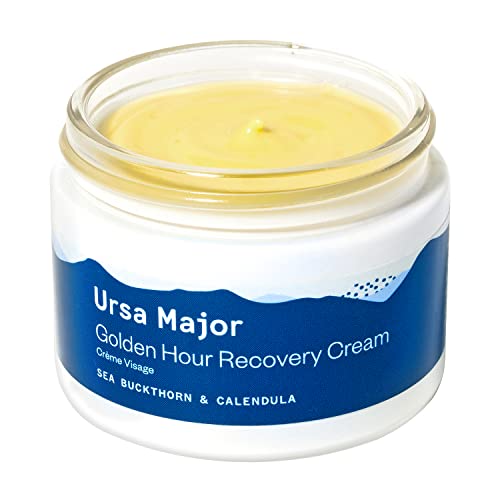
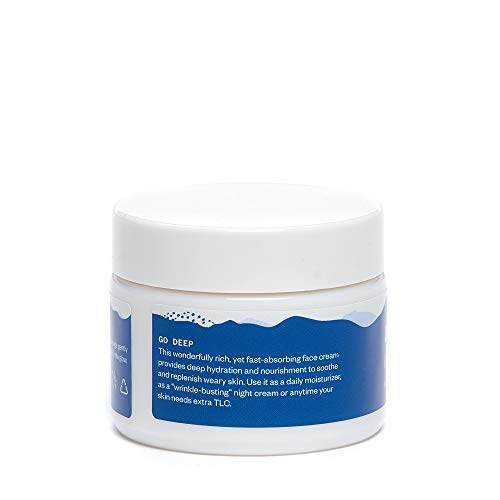
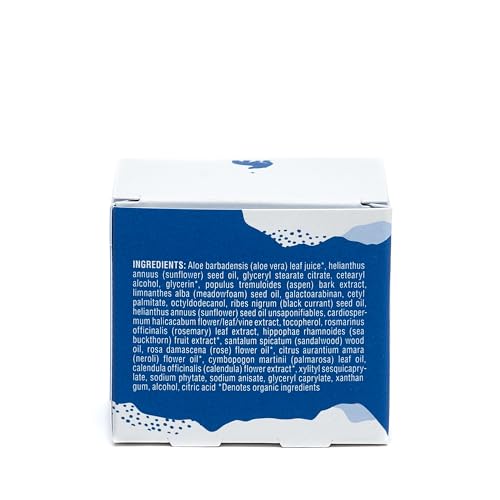
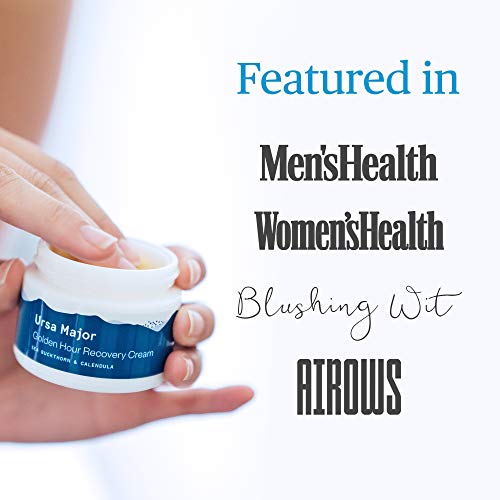
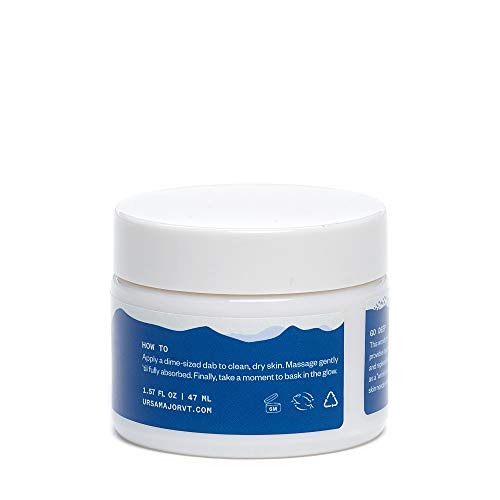
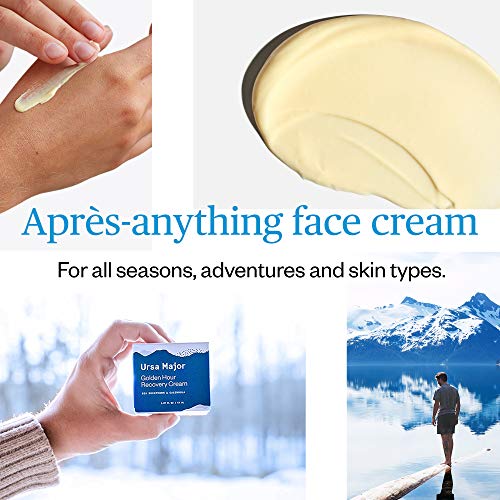
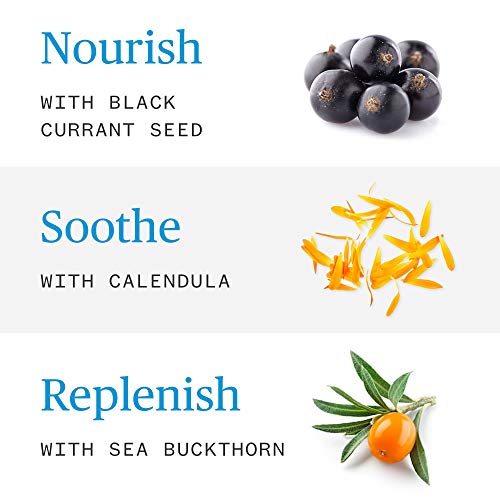
Ursa Major Face Moisturizer - Hydrating Recovery Cream, Natural Ingredients - 1.57 oz


Rosa Damascena Extract
High RiskRosa damascena extract is an extract of the rose species, primarily used in cosmetics for its fragrance and potential skin benefits. It is often incorporated into formulations for its soothing properties and is associated with aromatherapy applications.
Sustai Insights
Rosa damascena extract offers functional benefits such as fragrance enhancement and potential skin soothing effects, appealing to consumers seeking natural ingredients. However, it is associated with a high allergenic potential, and while it has low concerns regarding carcinogenicity and reproductive toxicity, it faces regulatory restrictions in verified products. Environmental risks include possible pollutants, and due to its high allergenic concerns, the overall risk assessment is high, warranting cautious use and consideration of alternatives.
Cymbopogon Martini (Palmarosa)
High RiskCymbopogon martini, commonly known as palmarosa, is a grass native to India and is primarily used for its essential oil, which serves as a fragrance and potential antibacterial agent in cosmetic formulations.
Sustai Insights
Palmarosa oil offers functional benefits including its use as a natural fragrance and potential antimicrobial properties. However, it has a high allergenic potential, posing risks of skin irritation and sensitization. Environmentally, it may not be significantly hazardous, but concerns about its cultivation practices exist. Regulatory bodies place some restrictions on its use, leading to an overall high risk assessment. Safe usage practices should be followed, and consideration for alternatives such as lavender or geranium oils may provide safer options.
Rosmarinus Officinalis (Rosemary) Leaf Extract
Medium RiskRosemary leaf extract is produced from the leaves of the Rosmarinus officinalis plant. It is commonly used in cosmetic formulations for its potential antioxidant properties and fragrance. The extract may also contribute to the preservation of products due to its antimicrobial characteristics.
Sustai Insights
Rosemary leaf extract offers functional benefits such as antioxidant and antimicrobial properties, which can enhance product stability and shelf-life. It is generally considered low risk for carcinogenicity and reproductive toxicity, but it carries a moderate potential for allergic reactions. Environmentally, it poses low risk with no significant pollutant or bioaccumulation concerns. Regulatory bodies have not placed significant restrictions on its use, although some verified products cannot contain certain concentrations. Overall, the ingredient's risk level is medium, necessitating careful usage practices to mitigate allergic responses.
Citric Acid
Medium RiskCitric acid is an alpha hydroxy acid used in personal care products primarily for its role as a pH adjuster and natural preservative. It occurs naturally in citrus fruits and is commonly utilized in various formulations for its chelating properties and mild exfoliation benefits.
Sustai Insights
Citric acid offers functional benefits as an effective preservative and pH stabilizer, contributing to product longevity and stability. It is biodegradable and derived from renewable sources. Health risks are low, with minimal concerns regarding carcinogenicity, allergies, and reproductive toxicity. However, moderate use restrictions exist due to potential irritation at high concentrations. Environmental risks are limited, as citric acid is not known to accumulate in ecosystems. Regulatory agencies have no significant advisories against its use. Overall, it is assessed as a medium-risk ingredient, with safe usage practices recommended and alternatives available.
Sodium Anisate
Low RiskSodium anisate is the sodium salt of p-anisic acid, commonly used as a preservative in various cosmetic and personal care products. It is recognized for its antimicrobial properties, which help to extend the shelf life of products by inhibiting the growth of bacteria and fungi.
Sustai Insights
Sodium anisate serves effectively as a preservative, offering antimicrobial benefits while being biodegradable and potentially sustainably sourced. Health risks are low, with minimal concerns regarding carcinogenicity, allergies, or reproductive toxicity. Environmentally, it poses low risks as it is not bioaccumulative. Regulatory bodies, including the EPA, do not impose significant restrictions on its use. Overall, sodium anisate presents a low risk, making it a favorable choice in formulations, although alternatives should be considered for those seeking greener options.
Xanthan Gum
Low RiskXanthan gum is a polysaccharide, a sugar-based compound produced by the fermentation of glucose or sucrose. It is commonly used as a thickening agent and stabilizer in various food and cosmetic products due to its ability to improve texture and prevent ingredient separation.
Sustai Insights
Xanthan gum serves effectively as a thickener and stabilizer, enhancing product texture and consistency. It is biodegradable and typically derived from renewable sources, supporting sustainability efforts. Health risks are minimal, with low concerns regarding carcinogenicity, allergies, and reproductive toxicity. Environmental impact is similarly low, posing no significant hazards. Regulatory agencies, including the FDA, regard it as safe for use, with no significant restrictions. Overall, xanthan gum is assessed as low risk, making it a suitable ingredient in formulations.
Ribes Nigrum (Blackcurrant) Seed Oil
Low RiskRibes nigrum (blackcurrant) seed oil is a fixed oil derived from the seeds of blackcurrant berries. It is primarily used in cosmetic and skincare formulations for its moisturizing and emollient properties, providing nourishment to the skin.
Sustai Insights
Ribes nigrum seed oil offers functional benefits such as hydration and skin barrier support and is sustainably sourced with low environmental impact. Health risks are minimal, with low concerns regarding carcinogenicity, allergies, and reproductive toxicity. It poses no significant environmental hazards and adheres to regulatory standards. Overall, this ingredient has a low risk profile, making it a suitable choice in formulations.
Octyldodecyl Ricinoleate
Low RiskOctyldodecyl ricinoleate is an ester of octyldodecanol and ricinoleic acid, primarily used as an emollient in cosmetic formulations. It functions to improve the texture and spreadability of products, providing a smooth feel upon application.
Sustai Insights
Octyldodecyl ricinoleate offers effective emollient properties that enhance product texture and skin feel. It is derived from ricinoleic acid, which is often sustainably sourced. Health risks are low, with no significant concerns regarding carcinogenicity, allergies, or reproductive toxicity. Environmental impacts are minimal, and regulatory status is compliant with safety standards. Overall, it is assessed as low risk, making it a suitable ingredient for cosmetic use.
Glyceryl Caprylate
Low RiskGlyceryl caprylate is a monoester of glycerin and caprylic acid, commonly used in cosmetics and personal care products as an emulsifier and skin-conditioning agent. It helps stabilize formulations and improve the texture and feel on the skin.
Sustai Insights
Glyceryl caprylate offers functional benefits as an effective emulsifier and skin-conditioning agent, enhancing product performance. It is biodegradable and considered sustainably sourced. Health risks are low, with minimal concerns regarding carcinogenicity, allergenic potential, and endocrine disruption. Environmental risks are also low, with no significant pollutant or bioaccumulation potential identified. Regulatory status is favorable, with no major restrictions. Overall, glyceryl caprylate maintains a low risk profile, making it a suitable ingredient for use in cosmetic formulations.
Sodium Phytate
Low RiskSodium phytate is a complex sodium salt of phytic acid, primarily used in cosmetic formulations as a chelating agent. It helps to stabilize formulations by binding metal ions, which can improve product efficacy and shelf life.
Sustai Insights
Sodium phytate offers functional benefits by enhancing product stability and is considered to have low health risks, with no significant associations with carcinogenicity, allergies, or reproductive toxicity. Environmentally, it poses minimal risks, as it is not considered a pollutant or bioaccumulative. Regulatory status indicates no significant restrictions. Overall, the ingredient is assessed as low risk. However, users should practice safe usage and consider alternatives like other chelating agents if desired.
Cetyl Palmitate
Low RiskCetyl palmitate is a lipid ingredient derived from cetyl alcohol and palmitic acid. It functions primarily as an emulsifier and thickening agent in cosmetic formulations, helping to stabilize and improve the texture of products such as creams and lotions.
Sustai Insights
Cetyl palmitate offers functional benefits as an effective emulsifier, enhancing product stability and texture. It is generally regarded as having low health risks, with minimal concerns regarding carcinogenicity, allergies, and irritation. Environmentally, it poses low risks and is not known for bioaccumulation. Regulatory bodies have not issued significant warnings, indicating compliance with safety standards. Overall, cetyl palmitate presents a low risk profile, making it a suitable choice in cosmetic formulations. For those seeking alternatives, other plant-based emulsifiers may provide similar functionality.
Limnanthes Versicolor (Meadowfoam) Seed Oil
Low RiskLimnanthes versicolor (meadowfoam) seed oil is derived from the seeds of the meadowfoam plant. It is commonly used in cosmetic formulations for its emollient properties, providing moisture and improving texture in skin and hair care products.
Sustai Insights
Meadowfoam seed oil offers functional benefits as a moisturizer and skin conditioner, being sustainably sourced and biodegradable. Health risks are minimal, with low concerns for carcinogenicity, allergies, and reproductive toxicity. Environmental risks are also low, with no significant pollutant potential. Current regulatory assessments do not indicate restrictions. Overall, this ingredient poses a low-risk profile, making it a suitable choice in cosmetic formulations.
Tocopherol, D Alpha
Low RiskTocopherol, specifically d-alpha tocopherol, is a naturally occurring form of Vitamin E. It is commonly used in cosmetic and personal care products primarily for its antioxidant properties, helping to protect formulations from oxidation and extend shelf life.
Sustai Insights
D-alpha tocopherol provides effective antioxidant benefits, contributing to product stability. It is sustainably sourced and generally regarded as safe, with low concerns regarding carcinogenicity, allergies, and reproductive toxicity. However, there are minor concerns about endocrine disruption. Regulatory bodies have not imposed significant restrictions, indicating low overall risk. Recommended usage practices include adhering to established safe concentration thresholds. Alternatives, such as other forms of Vitamin E or plant-based antioxidants, may also be considered.
Cardiospermum Halicacabum Flower/Leaf/Vine Extract
Low RiskCardiospermum halicacabum, commonly known as balloon vine, is a plant extract derived from its flowers, leaves, and vines. It is primarily used for its anti-inflammatory and soothing properties in cosmetic formulations.
Sustai Insights
Cardiospermum halicacabum offers functional benefits, such as anti-inflammatory effects, making it suitable for soothing skin irritations. It is not associated with significant health risks, including low concerns for carcinogenicity, allergies, or reproductive toxicity. Environmentally, it poses minimal risks and is not recognized as a pollutant. Regulatory evaluations indicate no current restrictions. The overall risk level is low, with safe usage practices recommended. Alternatives may include other botanical extracts with similar soothing properties, ensuring sustainable sourcing.
Vegetarian Glycerin
Low RiskVegetarian glycerin, also known as glycerol, is a colorless, odorless, and viscous liquid derived from plant sources. It is primarily used as a humectant, solvent, and emollient in various personal care products, helping to retain moisture and improve texture.
Sustai Insights
Vegetarian glycerin offers functional benefits as an effective humectant, promoting hydration and skin smoothness. It is biodegradable and typically sustainably sourced. Health risks associated with glycerin are low, with no significant concerns for carcinogenicity, allergens, or reproductive toxicity. Environmental risks are minimal, and it is not subject to major regulatory warnings. Overall, the risk level for this ingredient is low, making it a safe choice in formulations. Safe usage practices include ensuring proper concentrations in products, and alternatives such as propylene glycol exist but may have differing properties.
Glyceryl Stearate Citrate
Low RiskGlyceryl stearate citrate is a citric acid ester of glycerol and stearic acid, commonly used as an emulsifier and stabilizer in cosmetic formulations. It helps blend oil and water components, enhancing product texture and consistency.
Sustai Insights
Glyceryl stearate citrate offers functional benefits as an effective emulsifier, improving product stability and texture. It is considered safe, with low concerns for cancer, allergies, and reproductive toxicity. However, it may cause skin irritation in some individuals. Environmental risks are minimal, with no significant bioaccumulation or pollutant potential. Regulatory bodies have not placed significant restrictions on its use. Overall, the ingredient is assessed as low risk, with safe usage practices recommended, and alternatives may include other emulsifiers like cetearyl alcohol.
Cetearyl Alcohol
Low RiskCetearyl alcohol is a mixture of cetyl and stearyl alcohol, primarily used as an emulsifier and thickener in cosmetic formulations. It helps stabilize products, improve texture, and enhance moisturizing properties, making it common in creams and lotions.
Sustai Insights
Cetearyl alcohol offers functional benefits as an effective emulsifier and skin-conditioning agent, contributing to product stability and texture. It is generally recognized as safe, with low concerns for carcinogenicity, allergies, or reproductive toxicity. Environmental risks are minimal, as it is biodegradable and has low pollutant potential. Regulatory bodies have not imposed significant restrictions on its use. Overall, cetearyl alcohol is assessed to carry low risk, making it a suitable ingredient choice in cosmetic products.
Hippophae Rhamnoides (Sea Buckthorn) Fruit Extract
Low RiskHippophae rhamnoides fruit extract is an extract derived from the sea buckthorn plant, known for its rich content of vitamins, antioxidants, and fatty acids. It is primarily used in cosmetic formulations for its moisturizing, anti-inflammatory, and skin-repairing properties.
Sustai Insights
Hippophae rhamnoides fruit extract offers functional benefits such as moisturizing and anti-inflammatory effects, contributing to skin health. It is sustainably sourced and considered biodegradable. The ingredient presents low health risks, with minimal concerns regarding carcinogenicity and allergies. Environmental impacts are also low, with no significant pollutants or bioaccumulation reported. Regulatory assessments show no restrictions in major markets. Overall, it is deemed a low-risk ingredient, suitable for various applications.
Sclerotium Gum
Low RiskSclerotium gum is a polysaccharide gum produced by the fermentation of certain fungi. It serves primarily as a thickening, stabilizing, and gelling agent in various cosmetic formulations, contributing to texture and consistency.
Sustai Insights
Sclerotium gum offers functional benefits as a stabilizer and thickener in cosmetic products. It is considered low risk for health concerns, including carcinogenicity, allergies, and reproductive toxicity. Environmentally, it poses minimal risks and is not known to bioaccumulate. Regulatory agencies have not issued significant warnings, affirming its safety for use. Overall, the risk level associated with sclerotium gum is low, making it a viable ingredient in formulations, with no pressing need for alternatives.
Helianthus Annuus (Sunflower) Seed Oil Unsaponifiables
Low RiskHelianthus annuus (sunflower) seed oil unsaponifiables are derived from sunflower seeds and are commonly used in cosmetic formulations for their emollient properties. They contribute to the texture and stability of products and help to maintain skin hydration.
Sustai Insights
Helianthus annuus (sunflower) seed oil unsaponifiables provide significant functional benefits, including moisturizing properties and enhancing product stability. They are considered sustainably sourced and biodegradable. Health risks are low, with minimal concerns regarding carcinogenicity, allergies, or reproductive toxicity, while environmental impact is also low, posing no significant pollution risk. Regulatory reviews do not indicate any restrictions. Overall, this ingredient is assessed as low risk, making it a favorable option in cosmetic formulations.
Galactoarabinan
Low RiskGalactoarabinan is a polysaccharide obtained from the larch tree and is commonly used in cosmetic and personal care products. It acts as a humectant and thickening agent, contributing to product texture and moisture retention.
Sustai Insights
Galactoarabinan serves functional benefits as a humectant and thickening agent, enhancing product texture while retaining moisture. It is biodegradable and derived from renewable sources, supporting sustainability. Health risks are low, with no significant concerns regarding carcinogenicity, allergies, or reproductive toxicity. Environmental risks are minimal, as it does not contribute significantly to pollution or bioaccumulation. Regulatory status is favorable, with no current restrictions. Overall, this ingredient is assessed as low risk, making it a suitable choice in formulations.
Aloe Barbadensis (Aloe Vera) Leaf Extract
Low RiskAloe vera leaf extract is produced from the succulent leaves of the Aloe barbadensis plant. It is commonly used in cosmetic formulations for its moisturizing and soothing properties, making it a popular ingredient in skincare and personal care products.
Sustai Insights
Aloe vera leaf extract offers several functional benefits, including hydration and skin soothing effects, which are well-supported by scientific literature. It is considered to have a low risk for common health concerns such as carcinogenicity, allergies, or reproductive toxicity. Environmentally, it poses minimal risks, with no significant pollutant potential or bioaccumulation reported. Regulatory bodies have not imposed major restrictions, although verified products should not contain certain contaminants. Overall, this ingredient is assessed as low risk, with safe usage practices and the availability of alternative soothing agents if desired.
Leuconostoc/Radish Root Ferment Filtrate
Low RiskLeuconostoc/radish root ferment filtrate is a natural fermentation product derived from radish roots, commonly used in skincare for its potential preservative properties and skin-conditioning benefits. It functions by harnessing the metabolic activity of Leuconostoc bacteria to provide a source of beneficial compounds.
Sustai Insights
This ingredient offers functional benefits, primarily as a preservative and skin-conditioning agent, while being biodegradable and sustainably sourced. Health risks are generally low, with no significant concerns regarding carcinogenicity or allergies, though contamination concerns exist. Environmentally, it poses minimal risks, categorized as low overall risk based on current scientific consensus. Safe usage practices are advised, and alternatives may include other natural preservatives like tocopherol or rosemary extract.
Helianthus Annuus (Sunflower) Seed
Low RiskHelianthus annuus (sunflower) seed is derived from the seeds of the sunflower plant and is commonly used in various cosmetic and personal care products. It serves primarily as an emollient and skin conditioning agent, providing moisture and enhancing the texture of formulations.
Sustai Insights
Helianthus annuus (sunflower) seed offers functional benefits, including skin conditioning and moisturizing properties, while being sustainably sourced and biodegradable. Health risks are minimal, with low concerns for carcinogenicity, allergies, and reproductive toxicity. Environmentally, it presents low risks of pollution or bioaccumulation. Regulatory assessments indicate no current restrictions. Overall, it is considered a low-risk ingredient, and safe usage practices should be maintained. Alternative ingredients may include other plant-based oils, but the sunflower seed oil remains a viable option.
Sodium Anisate
Low RiskSodium anisate is the sodium salt of p-anisic acid, commonly used as a preservative in various cosmetic and personal care products. It is recognized for its antimicrobial properties, which help to extend the shelf life of products by inhibiting the growth of bacteria and fungi.
Sustai Insights
Sodium anisate serves effectively as a preservative, offering antimicrobial benefits while being biodegradable and potentially sustainably sourced. Health risks are low, with minimal concerns regarding carcinogenicity, allergies, or reproductive toxicity. Environmentally, it poses low risks as it is not bioaccumulative. Regulatory bodies, including the EPA, do not impose significant restrictions on its use. Overall, sodium anisate presents a low risk, making it a favorable choice in formulations, although alternatives should be considered for those seeking greener options.
Xanthan Gum
Low RiskXanthan gum is a polysaccharide, a sugar-based compound produced by the fermentation of glucose or sucrose. It is commonly used as a thickening agent and stabilizer in various food and cosmetic products due to its ability to improve texture and prevent ingredient separation.
Sustai Insights
Xanthan gum serves effectively as a thickener and stabilizer, enhancing product texture and consistency. It is biodegradable and typically derived from renewable sources, supporting sustainability efforts. Health risks are minimal, with low concerns regarding carcinogenicity, allergies, and reproductive toxicity. Environmental impact is similarly low, posing no significant hazards. Regulatory agencies, including the FDA, regard it as safe for use, with no significant restrictions. Overall, xanthan gum is assessed as low risk, making it a suitable ingredient in formulations.
Ribes Nigrum (Blackcurrant) Seed Oil
Low RiskRibes nigrum (blackcurrant) seed oil is a fixed oil derived from the seeds of blackcurrant berries. It is primarily used in cosmetic and skincare formulations for its moisturizing and emollient properties, providing nourishment to the skin.
Sustai Insights
Ribes nigrum seed oil offers functional benefits such as hydration and skin barrier support and is sustainably sourced with low environmental impact. Health risks are minimal, with low concerns regarding carcinogenicity, allergies, and reproductive toxicity. It poses no significant environmental hazards and adheres to regulatory standards. Overall, this ingredient has a low risk profile, making it a suitable choice in formulations.
Rosa Damascena Extract
High RiskRosa damascena extract is an extract of the rose species, primarily used in cosmetics for its fragrance and potential skin benefits. It is often incorporated into formulations for its soothing properties and is associated with aromatherapy applications.
Sustai Insights
Rosa damascena extract offers functional benefits such as fragrance enhancement and potential skin soothing effects, appealing to consumers seeking natural ingredients. However, it is associated with a high allergenic potential, and while it has low concerns regarding carcinogenicity and reproductive toxicity, it faces regulatory restrictions in verified products. Environmental risks include possible pollutants, and due to its high allergenic concerns, the overall risk assessment is high, warranting cautious use and consideration of alternatives.
Octyldodecyl Ricinoleate
Low RiskOctyldodecyl ricinoleate is an ester of octyldodecanol and ricinoleic acid, primarily used as an emollient in cosmetic formulations. It functions to improve the texture and spreadability of products, providing a smooth feel upon application.
Sustai Insights
Octyldodecyl ricinoleate offers effective emollient properties that enhance product texture and skin feel. It is derived from ricinoleic acid, which is often sustainably sourced. Health risks are low, with no significant concerns regarding carcinogenicity, allergies, or reproductive toxicity. Environmental impacts are minimal, and regulatory status is compliant with safety standards. Overall, it is assessed as low risk, making it a suitable ingredient for cosmetic use.
Glyceryl Caprylate
Low RiskGlyceryl caprylate is a monoester of glycerin and caprylic acid, commonly used in cosmetics and personal care products as an emulsifier and skin-conditioning agent. It helps stabilize formulations and improve the texture and feel on the skin.
Sustai Insights
Glyceryl caprylate offers functional benefits as an effective emulsifier and skin-conditioning agent, enhancing product performance. It is biodegradable and considered sustainably sourced. Health risks are low, with minimal concerns regarding carcinogenicity, allergenic potential, and endocrine disruption. Environmental risks are also low, with no significant pollutant or bioaccumulation potential identified. Regulatory status is favorable, with no major restrictions. Overall, glyceryl caprylate maintains a low risk profile, making it a suitable ingredient for use in cosmetic formulations.
Sodium Phytate
Low RiskSodium phytate is a complex sodium salt of phytic acid, primarily used in cosmetic formulations as a chelating agent. It helps to stabilize formulations by binding metal ions, which can improve product efficacy and shelf life.
Sustai Insights
Sodium phytate offers functional benefits by enhancing product stability and is considered to have low health risks, with no significant associations with carcinogenicity, allergies, or reproductive toxicity. Environmentally, it poses minimal risks, as it is not considered a pollutant or bioaccumulative. Regulatory status indicates no significant restrictions. Overall, the ingredient is assessed as low risk. However, users should practice safe usage and consider alternatives like other chelating agents if desired.
Cetyl Palmitate
Low RiskCetyl palmitate is a lipid ingredient derived from cetyl alcohol and palmitic acid. It functions primarily as an emulsifier and thickening agent in cosmetic formulations, helping to stabilize and improve the texture of products such as creams and lotions.
Sustai Insights
Cetyl palmitate offers functional benefits as an effective emulsifier, enhancing product stability and texture. It is generally regarded as having low health risks, with minimal concerns regarding carcinogenicity, allergies, and irritation. Environmentally, it poses low risks and is not known for bioaccumulation. Regulatory bodies have not issued significant warnings, indicating compliance with safety standards. Overall, cetyl palmitate presents a low risk profile, making it a suitable choice in cosmetic formulations. For those seeking alternatives, other plant-based emulsifiers may provide similar functionality.
Limnanthes Versicolor (Meadowfoam) Seed Oil
Low RiskLimnanthes versicolor (meadowfoam) seed oil is derived from the seeds of the meadowfoam plant. It is commonly used in cosmetic formulations for its emollient properties, providing moisture and improving texture in skin and hair care products.
Sustai Insights
Meadowfoam seed oil offers functional benefits as a moisturizer and skin conditioner, being sustainably sourced and biodegradable. Health risks are minimal, with low concerns for carcinogenicity, allergies, and reproductive toxicity. Environmental risks are also low, with no significant pollutant potential. Current regulatory assessments do not indicate restrictions. Overall, this ingredient poses a low-risk profile, making it a suitable choice in cosmetic formulations.
Tocopherol, D Alpha
Low RiskTocopherol, specifically d-alpha tocopherol, is a naturally occurring form of Vitamin E. It is commonly used in cosmetic and personal care products primarily for its antioxidant properties, helping to protect formulations from oxidation and extend shelf life.
Sustai Insights
D-alpha tocopherol provides effective antioxidant benefits, contributing to product stability. It is sustainably sourced and generally regarded as safe, with low concerns regarding carcinogenicity, allergies, and reproductive toxicity. However, there are minor concerns about endocrine disruption. Regulatory bodies have not imposed significant restrictions, indicating low overall risk. Recommended usage practices include adhering to established safe concentration thresholds. Alternatives, such as other forms of Vitamin E or plant-based antioxidants, may also be considered.
Cardiospermum Halicacabum Flower/Leaf/Vine Extract
Low RiskCardiospermum halicacabum, commonly known as balloon vine, is a plant extract derived from its flowers, leaves, and vines. It is primarily used for its anti-inflammatory and soothing properties in cosmetic formulations.
Sustai Insights
Cardiospermum halicacabum offers functional benefits, such as anti-inflammatory effects, making it suitable for soothing skin irritations. It is not associated with significant health risks, including low concerns for carcinogenicity, allergies, or reproductive toxicity. Environmentally, it poses minimal risks and is not recognized as a pollutant. Regulatory evaluations indicate no current restrictions. The overall risk level is low, with safe usage practices recommended. Alternatives may include other botanical extracts with similar soothing properties, ensuring sustainable sourcing.
Rosmarinus Officinalis (Rosemary) Leaf Extract
Medium RiskRosemary leaf extract is produced from the leaves of the Rosmarinus officinalis plant. It is commonly used in cosmetic formulations for its potential antioxidant properties and fragrance. The extract may also contribute to the preservation of products due to its antimicrobial characteristics.
Sustai Insights
Rosemary leaf extract offers functional benefits such as antioxidant and antimicrobial properties, which can enhance product stability and shelf-life. It is generally considered low risk for carcinogenicity and reproductive toxicity, but it carries a moderate potential for allergic reactions. Environmentally, it poses low risk with no significant pollutant or bioaccumulation concerns. Regulatory bodies have not placed significant restrictions on its use, although some verified products cannot contain certain concentrations. Overall, the ingredient's risk level is medium, necessitating careful usage practices to mitigate allergic responses.
Vegetarian Glycerin
Low RiskVegetarian glycerin, also known as glycerol, is a colorless, odorless, and viscous liquid derived from plant sources. It is primarily used as a humectant, solvent, and emollient in various personal care products, helping to retain moisture and improve texture.
Sustai Insights
Vegetarian glycerin offers functional benefits as an effective humectant, promoting hydration and skin smoothness. It is biodegradable and typically sustainably sourced. Health risks associated with glycerin are low, with no significant concerns for carcinogenicity, allergens, or reproductive toxicity. Environmental risks are minimal, and it is not subject to major regulatory warnings. Overall, the risk level for this ingredient is low, making it a safe choice in formulations. Safe usage practices include ensuring proper concentrations in products, and alternatives such as propylene glycol exist but may have differing properties.
Glyceryl Stearate Citrate
Low RiskGlyceryl stearate citrate is a citric acid ester of glycerol and stearic acid, commonly used as an emulsifier and stabilizer in cosmetic formulations. It helps blend oil and water components, enhancing product texture and consistency.
Sustai Insights
Glyceryl stearate citrate offers functional benefits as an effective emulsifier, improving product stability and texture. It is considered safe, with low concerns for cancer, allergies, and reproductive toxicity. However, it may cause skin irritation in some individuals. Environmental risks are minimal, with no significant bioaccumulation or pollutant potential. Regulatory bodies have not placed significant restrictions on its use. Overall, the ingredient is assessed as low risk, with safe usage practices recommended, and alternatives may include other emulsifiers like cetearyl alcohol.
Cetearyl Alcohol
Low RiskCetearyl alcohol is a mixture of cetyl and stearyl alcohol, primarily used as an emulsifier and thickener in cosmetic formulations. It helps stabilize products, improve texture, and enhance moisturizing properties, making it common in creams and lotions.
Sustai Insights
Cetearyl alcohol offers functional benefits as an effective emulsifier and skin-conditioning agent, contributing to product stability and texture. It is generally recognized as safe, with low concerns for carcinogenicity, allergies, or reproductive toxicity. Environmental risks are minimal, as it is biodegradable and has low pollutant potential. Regulatory bodies have not imposed significant restrictions on its use. Overall, cetearyl alcohol is assessed to carry low risk, making it a suitable ingredient choice in cosmetic products.
Hippophae Rhamnoides (Sea Buckthorn) Fruit Extract
Low RiskHippophae rhamnoides fruit extract is an extract derived from the sea buckthorn plant, known for its rich content of vitamins, antioxidants, and fatty acids. It is primarily used in cosmetic formulations for its moisturizing, anti-inflammatory, and skin-repairing properties.
Sustai Insights
Hippophae rhamnoides fruit extract offers functional benefits such as moisturizing and anti-inflammatory effects, contributing to skin health. It is sustainably sourced and considered biodegradable. The ingredient presents low health risks, with minimal concerns regarding carcinogenicity and allergies. Environmental impacts are also low, with no significant pollutants or bioaccumulation reported. Regulatory assessments show no restrictions in major markets. Overall, it is deemed a low-risk ingredient, suitable for various applications.
Sclerotium Gum
Low RiskSclerotium gum is a polysaccharide gum produced by the fermentation of certain fungi. It serves primarily as a thickening, stabilizing, and gelling agent in various cosmetic formulations, contributing to texture and consistency.
Sustai Insights
Sclerotium gum offers functional benefits as a stabilizer and thickener in cosmetic products. It is considered low risk for health concerns, including carcinogenicity, allergies, and reproductive toxicity. Environmentally, it poses minimal risks and is not known to bioaccumulate. Regulatory agencies have not issued significant warnings, affirming its safety for use. Overall, the risk level associated with sclerotium gum is low, making it a viable ingredient in formulations, with no pressing need for alternatives.
Citric Acid
Medium RiskCitric acid is an alpha hydroxy acid used in personal care products primarily for its role as a pH adjuster and natural preservative. It occurs naturally in citrus fruits and is commonly utilized in various formulations for its chelating properties and mild exfoliation benefits.
Sustai Insights
Citric acid offers functional benefits as an effective preservative and pH stabilizer, contributing to product longevity and stability. It is biodegradable and derived from renewable sources. Health risks are low, with minimal concerns regarding carcinogenicity, allergies, and reproductive toxicity. However, moderate use restrictions exist due to potential irritation at high concentrations. Environmental risks are limited, as citric acid is not known to accumulate in ecosystems. Regulatory agencies have no significant advisories against its use. Overall, it is assessed as a medium-risk ingredient, with safe usage practices recommended and alternatives available.
Helianthus Annuus (Sunflower) Seed Oil Unsaponifiables
Low RiskHelianthus annuus (sunflower) seed oil unsaponifiables are derived from sunflower seeds and are commonly used in cosmetic formulations for their emollient properties. They contribute to the texture and stability of products and help to maintain skin hydration.
Sustai Insights
Helianthus annuus (sunflower) seed oil unsaponifiables provide significant functional benefits, including moisturizing properties and enhancing product stability. They are considered sustainably sourced and biodegradable. Health risks are low, with minimal concerns regarding carcinogenicity, allergies, or reproductive toxicity, while environmental impact is also low, posing no significant pollution risk. Regulatory reviews do not indicate any restrictions. Overall, this ingredient is assessed as low risk, making it a favorable option in cosmetic formulations.
Galactoarabinan
Low RiskGalactoarabinan is a polysaccharide obtained from the larch tree and is commonly used in cosmetic and personal care products. It acts as a humectant and thickening agent, contributing to product texture and moisture retention.
Sustai Insights
Galactoarabinan serves functional benefits as a humectant and thickening agent, enhancing product texture while retaining moisture. It is biodegradable and derived from renewable sources, supporting sustainability. Health risks are low, with no significant concerns regarding carcinogenicity, allergies, or reproductive toxicity. Environmental risks are minimal, as it does not contribute significantly to pollution or bioaccumulation. Regulatory status is favorable, with no current restrictions. Overall, this ingredient is assessed as low risk, making it a suitable choice in formulations.
Aloe Barbadensis (Aloe Vera) Leaf Extract
Low RiskAloe vera leaf extract is produced from the succulent leaves of the Aloe barbadensis plant. It is commonly used in cosmetic formulations for its moisturizing and soothing properties, making it a popular ingredient in skincare and personal care products.
Sustai Insights
Aloe vera leaf extract offers several functional benefits, including hydration and skin soothing effects, which are well-supported by scientific literature. It is considered to have a low risk for common health concerns such as carcinogenicity, allergies, or reproductive toxicity. Environmentally, it poses minimal risks, with no significant pollutant potential or bioaccumulation reported. Regulatory bodies have not imposed major restrictions, although verified products should not contain certain contaminants. Overall, this ingredient is assessed as low risk, with safe usage practices and the availability of alternative soothing agents if desired.
Cymbopogon Martini (Palmarosa)
High RiskCymbopogon martini, commonly known as palmarosa, is a grass native to India and is primarily used for its essential oil, which serves as a fragrance and potential antibacterial agent in cosmetic formulations.
Sustai Insights
Palmarosa oil offers functional benefits including its use as a natural fragrance and potential antimicrobial properties. However, it has a high allergenic potential, posing risks of skin irritation and sensitization. Environmentally, it may not be significantly hazardous, but concerns about its cultivation practices exist. Regulatory bodies place some restrictions on its use, leading to an overall high risk assessment. Safe usage practices should be followed, and consideration for alternatives such as lavender or geranium oils may provide safer options.
Leuconostoc/Radish Root Ferment Filtrate
Low RiskLeuconostoc/radish root ferment filtrate is a natural fermentation product derived from radish roots, commonly used in skincare for its potential preservative properties and skin-conditioning benefits. It functions by harnessing the metabolic activity of Leuconostoc bacteria to provide a source of beneficial compounds.
Sustai Insights
This ingredient offers functional benefits, primarily as a preservative and skin-conditioning agent, while being biodegradable and sustainably sourced. Health risks are generally low, with no significant concerns regarding carcinogenicity or allergies, though contamination concerns exist. Environmentally, it poses minimal risks, categorized as low overall risk based on current scientific consensus. Safe usage practices are advised, and alternatives may include other natural preservatives like tocopherol or rosemary extract.
Helianthus Annuus (Sunflower) Seed
Low RiskHelianthus annuus (sunflower) seed is derived from the seeds of the sunflower plant and is commonly used in various cosmetic and personal care products. It serves primarily as an emollient and skin conditioning agent, providing moisture and enhancing the texture of formulations.
Sustai Insights
Helianthus annuus (sunflower) seed offers functional benefits, including skin conditioning and moisturizing properties, while being sustainably sourced and biodegradable. Health risks are minimal, with low concerns for carcinogenicity, allergies, and reproductive toxicity. Environmentally, it presents low risks of pollution or bioaccumulation. Regulatory assessments indicate no current restrictions. Overall, it is considered a low-risk ingredient, and safe usage practices should be maintained. Alternative ingredients may include other plant-based oils, but the sunflower seed oil remains a viable option.
Experience the revitalizing power of Ursa Major Golden Hour Face Moisturizer, a vegan recovery cream designed for daily hydration and skin repair. This luxurious moisturizer is perfect for all skin types, delivering deep moisture while enhancing your skin's natural barrier.
- Deep Hydration & Recovery: A rich formula that absorbs quickly, restoring weary skin and improving fine lines, dryness, and firmness for a youthful appearance.
- Plant-Based Goodness: Infused with sea buckthorn, calendula, and sunflower oils, this moisturizer is packed with antioxidants and essential fatty acids to nourish your skin naturally.
- Chemical-Free Assurance: Crafted with 100% vegan ingredients, this cruelty-free cream contains no parabens, sulfates, or synthetic additives, ensuring a gentle touch for your skin.
- Versatile Use: Ideal as a daily moisturizer or night cream, it boasts a soothing aroma of neroli and sandalwood, making it a delightful addition to your skincare routine.
- Suitable for Everyone: Whether you have normal, oily, combination, dry, or sensitive skin, enjoy smoother and healthier-looking skin without added shine.
Subscribe & Save with Sustai
- Best Price Guarantee: Always enjoy the lowest prices on sustainable home essentials.
- No Surprises: We’ll notify you before shipping. No hidden fees, ever.
- You’re in Charge: Change, pause, or cancel your subscription anytime with ease.
- Eco-Friendly Deliveries: Our grouped shipments mean less packaging and lower emissions.
Join us on a sustainable journey. Special offers for a limited time! Prices and promotions may change.
Recommended Products
Experience the revitalizing power of Ursa Major Golden Hour Face Moisturizer, a vegan recovery cream designed for daily hydration and skin repair. This luxurious moisturizer is perfect for all skin types, delivering deep moisture while enhancing your skin's natural barrier.
- Deep Hydration & Recovery: A rich formula that absorbs quickly, restoring weary skin and improving fine lines, dryness, and firmness for a youthful appearance.
- Plant-Based Goodness: Infused with sea buckthorn, calendula, and sunflower oils, this moisturizer is packed with antioxidants and essential fatty acids to nourish your skin naturally.
- Chemical-Free Assurance: Crafted with 100% vegan ingredients, this cruelty-free cream contains no parabens, sulfates, or synthetic additives, ensuring a gentle touch for your skin.
- Versatile Use: Ideal as a daily moisturizer or night cream, it boasts a soothing aroma of neroli and sandalwood, making it a delightful addition to your skincare routine.
- Suitable for Everyone: Whether you have normal, oily, combination, dry, or sensitive skin, enjoy smoother and healthier-looking skin without added shine.

You can have at most 2 Sustainable Steals products in your cart
Customer Reviews
Customers’ View
Customers appreciate the Ursa Major Golden Hour Face Moisturizer for its effective moisturizing properties and natural formulation. Many users highlight the product's ability to deeply hydrate without feeling heavy or greasy, noting that it leaves their skin feeling soft, smooth, and radiant throughout the day. The lightweight texture, described as silky and buttery, enhances its appeal among consumers, especially those with sensitive skin. Additionally, the pleasant scent, reminiscent of light citrus, is frequently praised, although some have mixed feelings about it. While the majority find the product delivers good value, a few customers express concerns about skin irritation. Overall, this moisturizer is recognized for its eco-friendly, vegan ingredients, aligning well with the values of health-conscious consumers.
AI-generated from the text of customer reviewsThis product is rated 4.6 of 5.0 stars.
It has received 54 reviews.




